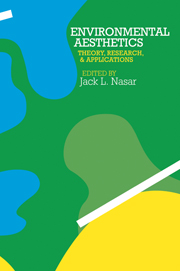Book contents
- Frontmatter
- Contents
- List of figures
- List of tables
- List of contributors and participants
- Acknowledgments
- Preface
- Section I Theory
- Section II Empirical studies
- Section III Applications
- Editor's introduction
- 27 Visual needs in urban environments and physical planning
- 28 A survey of aesthetic controls in English speaking countries
- 29 Scenic-beauty issues in public policy making
- 30 Coping with aesthetics and community design in rural communities
- 31 Toward theory generation in landscape aesthetics
- 32 Aesthetic regulation and the courts
- References
- Index of authors
- Subject index
29 - Scenic-beauty issues in public policy making
Published online by Cambridge University Press: 05 September 2013
- Frontmatter
- Contents
- List of figures
- List of tables
- List of contributors and participants
- Acknowledgments
- Preface
- Section I Theory
- Section II Empirical studies
- Section III Applications
- Editor's introduction
- 27 Visual needs in urban environments and physical planning
- 28 A survey of aesthetic controls in English speaking countries
- 29 Scenic-beauty issues in public policy making
- 30 Coping with aesthetics and community design in rural communities
- 31 Toward theory generation in landscape aesthetics
- 32 Aesthetic regulation and the courts
- References
- Index of authors
- Subject index
Summary
The landscape has been shaped by complex factors, both physical and cultural. One social process that has left its mark on the land is public policy (i.e., government action). Although the making of public policy is not always apparent to the general public, its effects are apparent. For example, government decisions to set aside public land, to construct interstate highways, or to extend sewer lines into rural areas have their effects: areas of natural scenery, isolated nodes of commercial development, sprawling subdivisions. Each decision contributes to shaping the world we see, as well as the way we live.
Visual quality, like clean air and fertile soils, is one of the nation's natural resources (Council on Environmental Quality, 1970). The value that our society places on visual beauty can be seen in the setting aside of national parks and in the immense numbers of people who visit these parks every year. While the national policy of scenic protection focuses primarily on spectacular settings, such as Yellowstone or the Grand Canyon, local governments and private citizens indicate their concern for the visual quality of the everyday environment by establishing architectural review boards, downtown improvement associations, garden clubs, and other such organizations. The economic expression of this concern for beautiful surroundings is clear if we compare the real-estate value of a property with a magnificent ocean view and a home with a view of the house next door. The economic incentive for visual quality also leads towns and cities to refurbish or thoroughly redesign their downtown commercial districts. On a broader scale, scenic beauty provides a critical resource base for the tourism industry, a major component of the economy in a number of states.
- Type
- Chapter
- Information
- Environmental AestheticsTheory, Research, and Application, pp. 434 - 448Publisher: Cambridge University PressPrint publication year: 1988



